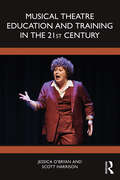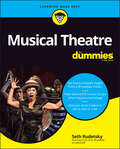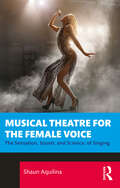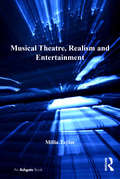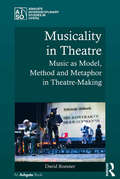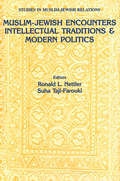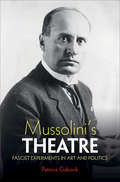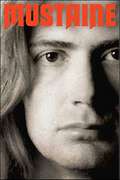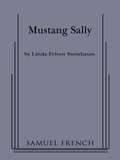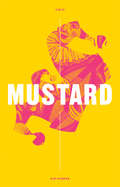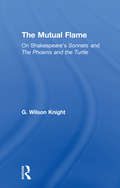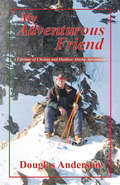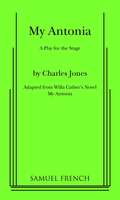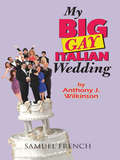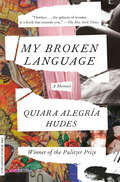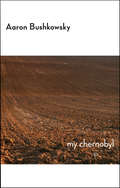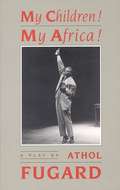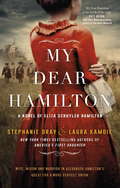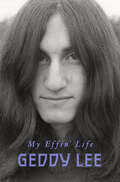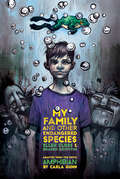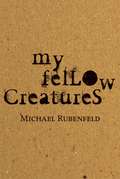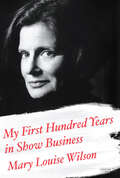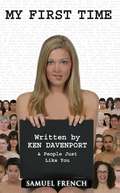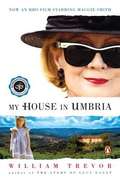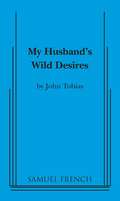- Table View
- List View
Musical Theatre Education and Training in the 21st Century
by Scott D. Harrison Jessica O'BryanMusical Theatre Education and Training in the 21st Century presents a wide range of viewpoints on the musical theatre profession. It brings together research from the UK, US, Australia, and beyond, providing an essential resource for educators, students, and all those involved in training for musical theatre. The research draws on best practice from creatives, producers, practising artists, and the academy to reveal a multiplicity of approaches and educational pathways for consideration by performers, educators, institutions, and the profession.The book goes beyond the key elements of performance training in singing, dancing, and acting to explore adjacent creative and business skills, along with some of the more recent and challenging aspects of the profession such as diversity of representation both on and off stage, building safe working environments, and managing mental and physical health and wellbeing. The authors incorporate information from over 100 interviews with everyone from emerging performers to leading professionals, and explore the practicalities of pre-professional training, skills development, and curricular design, alongside the broader attributes required in preparation for the profession. This book offers vital insights into how musical theatre practitioners can best be prepared to make their way in the field now and in the future.
Musical Theatre For Dummies
by Seth RudetskyDiscover what goes on behind the curtains of your favorite musical Have you ever dreamed of being in a Broadway musical, or even just to be in the ensemble in your local community theatre? In Musical Theater For Dummies, Broadway insider and host of Sirus/XM Radio’s ON BROADWAY channel Seth Rudetsky takes you backstage and shows you what it takes to create a spectacular production. You’ll get the behind-the-curtain view of how your favorite on- and off-Broadway shows are made, plus get expert advice on how to launch your own career under the bright lights. If you’re new to musical theater, this book will initiate you into the world of musicals by sharing the stories and lingo that defines this fascinating world. This unique book shares insights into what makes musical theatre tick and how you can enjoy a show from your seat in the audience or from the stage itself. Learn the history of musical theater and discover the shows born on Broadway or the West End that became cultural phenomena Trace the development of productions, from the idea stage all the way through opening night and beyond Enjoy theater productions more, thanks to deep insights into how theater is made Get insider advice on the skills you need to perform in professional or amateur musical theater productions Real-life anecdotes and excellent show recommendations will entertain and delight you as you become a musical theater know-it-all, with Dummies.
Musical Theatre for the Female Voice: The Sensation, Sound, and Science, of Singing
by Shaun AquilinaFemale musical theatre singers produce some of the most exciting and expressive singing an audience can experience. They also face a unique and specific set of issues when approaching their craft, from negotiating the registers of their voice to enable them to belt, to vocal health challenges such as premenstrual voice syndrome. This is the only book that offers a full and detailed guide to tackling those issues and to singing with full expression and technical excellence. Musical Theatre for the Female Voice covers the origin of singing in musicals, from the bel canto style of 300 years ago through to the latest developments in high belting, in shows such as Wicked and Waitress. It offers the reader exercises and methods that have been used to train hundreds of singers at some of the UK’s leading musical theatre training institutions and are underpinned by the latest academic research in journals on singing, psychology, and health. Every element of a singer's toolkit is covered from a female perspective, from breath and posture to character work and vocal health. This is an essential guidebook for female singers in musical theatre productions, either training at university or conservatory level or forging a career as professional triple-threat performers.
Musical Theatre, Realism and Entertainment (Ashgate Interdisciplinary Studies in Opera)
by Millie TaylorWhat is it about musical theatre that audiences find entertaining? What are the features that lead to its ability to stimulate emotional attachment, to move and to give pleasure? Beginning from the passion musical theatre performances arouse and their ubiquity in London's West End and on Broadway this book explores the ways in which musical theatre reaches out to and involves its audiences. It investigates how pleasure is stimulated by vocal, musical and spectacular performances. Early discussions centre on the construction of the composed text, but then attention is given to performance and audience response. Musical theatre contains disruptions and dissonances in its multiple texts, it allows gaps for audiences to read playfully. This combines with the voluptuous sensations of embodied emotion, contagiously and viscerally shared between audience and stage, and augmented through the presence of voice and music. A number of features are discovered in the construction of musical theatre performance texts that allow them to engage the intense emotional attachment of their audiences and so achieve enormous popularity. In doing this, the book challenges the conception of musical theatre as 'only entertainment'. Entertainment instead becomes a desirable, ephemeral and playful concept.
Musicality in Theatre: Music as Model, Method and Metaphor in Theatre-Making (Ashgate Interdisciplinary Studies in Opera)
by David RoesnerAs the complicated relationship between music and theatre has evolved and changed in the modern and postmodern periods, music has continued to be immensely influential in key developments of theatrical practices. In this study of musicality in the theatre, David Roesner offers a revised view of the nature of the relationship. The new perspective results from two shifts in focus: on the one hand, Roesner concentrates in particular on theatre-making - that is the creation processes of theatre - and on the other, he traces a notion of ‘musicality’ in the historical and contemporary discourses as driver of theatrical innovation and aesthetic dispositif, focusing on musical qualities, metaphors and principles derived from a wide range of genres. Roesner looks in particular at the ways in which those who attempted to experiment with, advance or even revolutionize theatre often sought to use and integrate a sense of musicality in training and directing processes and in performances. His study reveals both the continuous changes in the understanding of music as model, method and metaphor for the theatre and how different notions of music had a vital impact on theatrical innovation in the past 150 years. Musicality thus becomes a complementary concept to theatricality, helping to highlight what is germane to an art form as well as to explain its traction in other art forms and areas of life. The theoretical scope of the book is developed from a wide range of case studies, some of which are re-readings of the classics of theatre history (Appia, Meyerhold, Artaud, Beckett), while others introduce or rediscover less-discussed practitioners such as Joe Chaikin, Thomas Bernhard, Elfriede Jelinek, Michael Thalheimer and Karin Beier.
Muslim-Jewish Encounters (Studies In Muslim-jewish Relations Ser. #Vol. 4.)
by NettlerFirst Published in 1998. Routledge is an imprint of Taylor & Francis, an informa company.
Mussolini's Theatre: Fascist Experiments in Art and Politics
by Patricia GaborikBenito Mussolini has persistently been described as an 'actor' – and also as a master of illusions. In her vividly narrated account of the Italian dictator's relationship with the theatre, Patricia Gaborik discards any metaphorical notions of Il Duce as a performer and instead tells the story of his life as literal spectator, critic, impresario, dramatist and censor of the stage. Discussing the ways in which the autarch's personal tastes and convictions shaped, in fascist Italy, theatrical programming, she explores Mussolini's most significant dramatic influences, his association with important figures such as Luigi Pirandello, Gabriele D'Annunzio and George Bernard Shaw, his oversight of stage censorship, and his forays into playwriting. By focusing on its subject's manoeuvres in the theatre, and manipulation of theatrical ideas, this consistently illuminating book transforms our understandings of fascism as a whole. It will have strong appeal to readers in both theatre studies and modern Italian history.
Mustaine: A Heavy Metal Memoir
by Joe Layden Dave MustaineNew York Times BestsellerFounding member, singer, and lead guitarist of Metallica and Megadeath shares the ultimate, unvarnished story behind his involvement in the rise of two of the world’s most influential heavy metal bands in history. Dave Mustaine is the first to admit that he’s bottomed out a few times in his dark and twisted speed metal version of a Dickensian life. From his soul-crushing professional and artistic setbacks to his battle with addiction, Mustaine has hit rock bottom on multiple occasions. April 1983 was his lowest point, when he was unceremoniously fired from Metallica for his hard-partying ways. But, what seemed to be the end of it all was just the beginning for the guitarist. After parting ways with Metallica, Mustaine went on to become the front man, singer, songwriter, guitarist (and de facto CEO) for Megadeath—one of the most successful metal bands in the world. A pioneer of the thrash metal movement, Megadeath rose to international fame in the 1980s, and has gone on to earn seven consecutive Grammy nominations for Best Metal Performance. In this outrageously candid memoir, one of heavy metal’s most iconic figures gives an insider’s look into the loud and sordid world of thrash metal—sex, drugs, and rock n’ roll included.
Mustang Sally
by Linda Felton Steinbaum2m,3f / Drama / Interior / Mustang Sally tackles the timely and sensitive topic of female teachers who have sex with their underage students, justice, and double standards. As the play begins, the affair between Sal, a 13-year old male middle school student, and his 31-year old teacher, Kathy, has already been discovered. Kathy’s older, successful and high-powered, commitment phobic sister Elizabeth, steps forward to take charge and help. She quickly enlists the aid of one of her suitors, a divorced male attorney, Edward. Elizabeth attempts to solve Kathy’s problems while also trying to navigate her own life, and curb her religiously fanatic mothers destructive behavior. Along the way, deep family issues are uncovered, the result being an involving and insightful drama that provides food for thought about serious subjects.
Mustard
by Kat SandlerMustard shouldn’t still be here, but he is. Imaginary friends don’t normally stay with their Person until that Person is a troubled teenager, exhibiting strangely violent behaviour. Imaginary friends don’t suddenly become visible to their Person’s mom and then go on a date with them, either. But Mustard is special. At least that’s what he thinks. And he’s not ready to leave his best friend, Thai, even though he’s in deep trouble with some unsavoury characters who are ready to enforce some serious rules. And, oh yeah, he’s falling in love with Sadie, Thai’s recently separated, wine-guzzling mom, who doesn’t believe he’s real. A twisted fairy tale about friendship, love, growing up, moving on and finding magic where you least expect it, this darkly comedic bedtime story by Canadian theatre’s indie darling blurs imagination with reality in order to save a family from its own destruction.
Mutual Flame - Wilson Knight V: On Shakespeare's Sonnets And The Phoenix And The Turtle
by Wilson KnightFirst Published in 2002. Routledge is an imprint of Taylor & Francis, an informa company.
My Adventurous Friend: A Lifetime of Choices and Outdoor Alaska Adventures
by Anderson DouglasMy Adventurous Friend is based on accounts of my friend Hagen's life, as he related it to me, and of the adventures we enjoyed together in Alaska. We would reminisce while sitting around a campfire in some wilderness area during our hikes and gold prospecting ventures. We could be debating current events and somehow our talk would drift back to events of earlier times. Over the years, piece by piece, I learned almost everything there was to know about my friend. Hagen had a varied and adventurous life beginning in wartime Germany and, by a circuitous route, eventually migrated to Alaska in 1973. Hagen had a longing for adventure and was never satisfied with the status-quo. He was strong, tenacious and once his mind was made up he would seldom deviate. In his mind, if it wasn't difficult then it wasn't worth doing. He always said he was born one hundred years too late to be a real pioneer but he sure did his best to emulate them. Hiking to our gold claim--forty miles from the nearest gravel road--and making it there alone in the dead of the Alaska winter was almost enough to satisfy his craving for adventure.
My Antonia
by Charles JonesDrama / 11m, 7f, 7 children / Unit set This faithful adaptation brings the wonderful romantic novel's profoundly human characters and its expansive view of 19th century American frontier life vibrantly to the stage. The play celebrates Antonia's story and her extraordinary delight in the happenings of daily life. It moves from the raw hardships of her immigrant family's first year as settlers on the plains through her joyful and rebellious youth to her fulfillment as a farm wife and mother. "No romantic novel ever written in America is one half so beautiful as My Antonia." -H.L. Mencken
My Big Gay Italian Wedding
by Anthony WilkinsonComedy / Characters: 10 male, 6 female / Andrew and Anthony are getting married - and everyone wants to "help"! My Big Gay Italian Wedding spins into a hysterical fiasco as everyone tries to have their way. From a saboteur ex-boyfriend to a loud, opinionated, outspoken Italian mother, personalities and culture collide in a music and dance-filled extravaganza. / "Feel-good hysterical comedy!" -The Wall Street
My Broken Language: A Memoir
by Quiara Alegría HudesA Pulitzer Prize–winning playwright tells her lyrical story of coming of age against the backdrop of an ailing Philadelphia barrio, with her sprawling Puerto Rican family as a collective muse. &“Quiara Alegría Hudes is in her own league. Her sentences will take your breath away. How lucky we are to have her telling our stories.&”—Lin-Manuel Miranda, award-winning creator of Hamilton Quiara Alegría Hudes was the sharp-eyed girl on the stairs while her family danced in her grandmother&’s tight North Philly kitchen. She was awed by her aunts and uncles and cousins, but haunted by the secrets of the family and the unspoken, untold stories of the barrio—even as she tried to find her own voice in the sea of language around her, written and spoken, English and Spanish, bodies and books, Western art and sacred altars. Her family became her private pantheon, a gathering circle of powerful orisha-like women with tragic real-world wounds, and she vowed to tell their stories—but first she&’d have to get off the stairs and join the dance. She&’d have to find her language. Weaving together Hudes&’s love of books with the stories of her family, the lessons of North Philly with those of Yale, this is an inspired exploration of home, memory, and belonging—narrated by an obsessed girl who fought to become an artist so she could capture the world she loved in all its wild and delicate beauty.
My Chernobyl
by Aaron BushkowskyWhile there, he meets his long-lost cousin, a beautiful, young Russian woman, who sets her sights on her wealthy relative as a ticket out of the radiation-blasted country. My Chernobyl is a quirky romance set in the existential old country, where cultures and ideals clash with touching and hilarious results.
My Children! My Africa!
by Athol FugardThe search for a means to an end to apartheid erupts into conflict between a black township youth and his "old-fashioned" black teacher.
My Dear Hamilton: discover Eliza's story . . . perfect for fans of hit musical Hamilton!
by Stephanie Dray Laura KamoieLove Lin-Manuel Miranda's hit musical Hamilton? Discover the untold story of the brilliant Eliza Schuyler Hamilton!Coming of age in revolutionary New York, Elizabeth Schuyler is proud to champion the fight for independence. And when she meets Alexander Hamilton, Washington's penniless but passionate right hand man, she's captivated by the young officer's charisma and brilliance. Despite the perilous times and Alexander's background, they fall in love and are soon married. From glittering balls to bloody street riots, the Hamiltons are at the centre of it all - including America's first sex scandal, which forces Eliza to struggle through heartbreak and betrayal to find forgiveness. And when a duel destroys Eliza's hard-won peace, the grieving widow fights her husband's enemies to preserve Alexander's legacy. But long-buried secrets threaten everything Eliza believes about her marriage and her own legacy. Questioning her tireless devotion to the man and country that have broken her heart, she's left with one last battle - to understand the flawed man she married and imperfect union he could never have created without her . . .Haunting, moving, and beautifully written, Dray and Kamoie use thousands of letters and original sources to tell Eliza's story as it's never been told before - not just as the wronged wife but as a strong woman who shaped an American legacy in her own right.'Full of history, engaging characters who shimmer on each page, and a tremendous love story, this is a book for everyone' Karen White, New York Times bestselling author'An unforgettable story of the woman behind Hamilton - a triumph!' Pam Jenoff, New York Times bestselling author'My Dear Hamilton is the book of the year' Kate Quinn, USA Today bestselling author of The Alice Network'Historical fiction at its most addictive!' Stephanie Thornton, author of The Tiger Queens'An incredible, surprising, and altogether lovely tribute to the woman who stood beside one of the most unknowable, irascible, energetic, and passionate of men' Lars Hedbor, author of The Path: Tales from a Revolution
My Effin' Life
by Geddy LeeThe long-awaited memoir, generously illustrated with never-before-seen photos, from the iconic Rock and Roll Hall of Famer, Rush bassist, and New York Times bestselling author of Geddy Lee's Big Beautiful Book of Bass.Geddy Lee is one of rock and roll's most respected bassists. For nearly five decades, his playing and work as co-writer, vocalist and keyboardist has been an essential part of the success story of Canadian progressive rock trio Rush. Here for the first time is his account of life inside and outside the band.Long before Rush accumulated more consecutive gold and platinum records than any rock band after the Beatles and the Rolling Stones, before the seven Grammy nominations or the countless electrifying live performances across the globe, Geddy Lee was Gershon Eliezer Weinrib, after his grandfather was murdered in the Holocaust.As he recounts the transformation, Lee looks back on his family, in particular his loving parents and their horrific experiences as teenagers during World War II.He talks candidly about his childhood and the pursuit of music that led him to drop out of high school.He tracks the history of Rush which, after early struggles, exploded into one of the most beloved bands of all time.He shares intimate stories of his lifelong friendships with bandmates Alex Lifeson and Neil Peart—deeply mourning Peart’s recent passing—and reveals his obsessions in music and beyond.This rich brew of honesty, humor, and loss makes for a uniquely poignant memoir.
My Family and Other Endangered Species
by Ellen Close Braden GriffithsNine-year-old Phineas interprets the world through his encyclopedic knowledge of animals, but some human behaviour is just too puzzling. Take for example his mom, who insists he learn to fall asleep on his own, even though all young mammals sleep with their mothers; or his dad, who recently picked up and left the family, a behaviour quite unlike other mate-for-life animals. And then there’s the constant news from his favourite TV station, the Green Channel, about how humans are ruining the environment, a fact Phin is growing increasingly anxious about. So when his fourth-grade class gets a White’s tree frog as a pet, all of Phin’s anxieties come to a boil.
My Fellow Creatures
by Michael RubenfeldVenturing into dark and explosive territory, My Fellow Creatures is a raw, honest, and thoughtful portrayal of these men and their virtues, confronting the reader with difficult questions about love, consent, vengeance, and acceptance.
My First Hundred Years in Show Business: A Memoir
by Mary Louise WilsonThis Tony winner&’s memoir is &“a riot of characters met and characters played . . . a funny, frank, and savvy chronicle of a wonderful life.&” —David Hyde Pierce Mary Louise Wilson became a star at age sixty with her smash one-woman play Full Gallop, portraying legendary Vogue editor Diana Vreeland. But before and since, her life and career—including the Tony Award for her portrayal of Big Edie in Grey Gardens—have been celebrated and varied. Raised in New Orleans with a social climbing, alcoholic mother, Mary Louise moved to New York City in the late 1950s; lived with her gay brother in the Village; entered the nightclub scene in a legendary revue; and rubbed shoulders with every famous person of that era and since. My First Hundred Years in Show Business gets it all down. Yet as delicious as the anecdotes are, the heart of this book is in its unblinkingly honest depiction of the life of a working actor. In her inimitable voice—wry, admirably unsentimental, mordantly funny—Mary Louise Wilson has crafted a work that is at once a teeming social history of the New York theatre scene and a thoroughly revealing, superbly entertaining memoir of the life of an extraordinary woman and actor. &“Brims with anecdotes . . . plenty of laughs [and] plenty of candor, too.&” —Nola.com
My First Time
by Ken DavenportComedy / Characters: 2m, 2f / Set: Simple Set "I remember my first sexual experience. I was alone at the time!” (Story #6509)“I still have the Metallica shirt he wore that night.” (Story #23960)“File mine under clumsy and awkward!” (Story #4294)My First Time features four actors in hysterical and heartbreaking stories about first sexual experiences written by real people. In 1998, a decade before blogging began, a website was created that allowed people to anonymously share their own true stories about their First Times. The website became an instant phenomenon as over 40,000 stories poured in from around the globe that were silly, sweet, absurd, funny, heterosexual, homosexual, shy, sexy and everything in between. And now, these true stories and all of the unique characters in them are brought to life by four actors in this acclaimed 90 minute play from Ken Davenport, producer of Altar Boyz and creator of The Awesome 80s Prom. "Funny and touching to sweet, sexy and silly!"- The Village Voice "One of New York's best new plays! Phenomenal!" -EdgeNewYork.com
My House in Umbria
by William TrevorMrs. Emily Delahunty-a mysterious and not entirely trustworthy former madam-quietly runs a pensione in the Italian countryside and writes romance novels while she muses on her checkered past. Then one day her world is changed forever as the train she is riding in is blown up by terrorists. Taken to a local hospital to recuperate, she befriends the other survivors-an elderly English general, an American child, and a German boy-and takes them all to convalesce at her villa, with unforeseen results.
My Husband's Wild Desires
by John TobiasFull Length, Comedy / Characters: 3m, 2f / Interior set / A super-macho business executive suddenly has problems in the bedroom with his long-term wife and mother of his grown children. Failure in any part of his life has never been an option for him. So he recruits his wife into solving the problem through the "Live Your Fantasy" sex-therapy technique pioneered by Dr. Leopold Baumgartner. The wife discovers the dominatrix/diva that has been buried beneath the gracious hostess, and they blackmail their hi-rise super and a nervous burglar into taking part in the sex therapy. The result is a comedy of fantasies gone wrong , taboos colliding with hidden yearnings, and sex-role switches run amok. A hit on four continents! "A sensation - so funny that you will cry from laughter. Wild Desires is attracting thousands of people to the Bajka Theatre." - Imperium TV and TV Weekly, Warsaw, Poland. "A great success. The audience leaves it rolling over and over with laughter." - Montreal's leading theatre critic, Daniel Guerard on Bon Dimattche. "The town's best laugh!" - B. T., Copenhagen. "Straight in the bull's eye. The audience laughs its head off, thanks to the light and piquant humor of the play...Outstanding for the modernity of its mockery."-Veja, Brazil. "Almost drove the audience wild...One of the greatest nights of ongoing laughter the audience has given us since I can't remember when." WNEDT-TV, New York, Studio Arena Theatre production.
